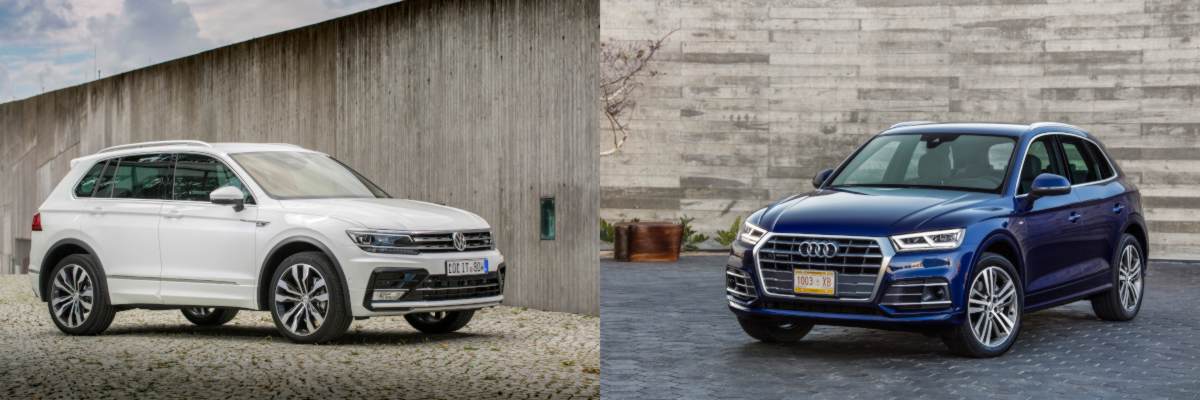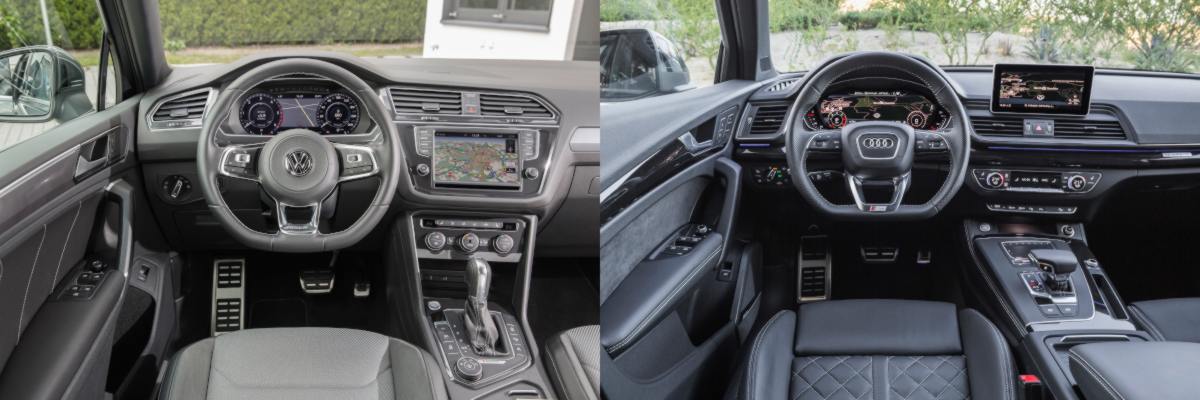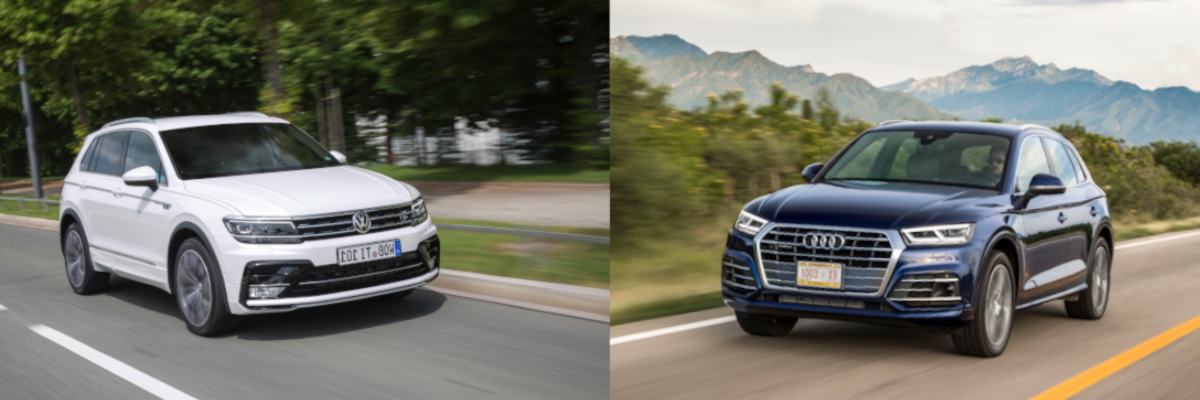For several years now, crossover SUVs have been a popular style of car - and when it comes to high quality it’s the German models that most drivers set their hearts on. We compare the Volkswagen Tiguan and Audi Q5 to see how these two sporty crossovers measure up.
Exterior

To keep the comparison fair, we’ll leave the 7-seat Tiguan Allspace model out of the picture and stick to the standard 5-seat version of VW’s Tiguan, which is 17.7cm shorter than the Q5, so it’s only smaller by a narrow margin - and the two crossovers are of similar height.
Audi purposefully designed the second generation of its mid-size SUV to reflect the sportiness of its saloons and coupés, and the bold 3D grille endows it with strong road presence, while its sculpted sides and curvaceous roofline give it an agile stance, finished off beautifully by Audi’s optional and mesmerising Matrix lights.
Now also in its second generation, the latest Volkswagen Tiguan is somewhat more linear to behold but it oozes sophistication. Its full-width grille may be more subtle but looks superb, especially in higher trim levels that see horizontal chrome accents added, while the rear light clusters echo the Golf but incorporate clever lower cut-outs. Unsurprisingly, both the Tiguan and Q5 look at their sporty best in range-topping R-Line and S-Line guises respectively.
Conclusion: The Volkswagen Tiguan R-Line looks the more sporty and aggressive, but the Q5 is larger and ahs the classic, sleek Audi look. It really comes down to personal preference on this one.
Interior

Built on the same platform and part of the same automotive group, it’s no surprise that some of the buttons and controls inside the new Volkswagen Tiguan and Audi Q5 appear somewhat similar. On closer inspection, while VW’s interiors have become decidedly more premium in recent years, the Audi has a more luxurious aura and ultimately feels more special.
The biggest visual difference is that the Tiguan’s 8-inch infotainment touchscreen, standard from SE trim and higher, is positioned at the top of the centre console. The latest Q5’s screen, meanwhile, is controlled by the car’s MMI controller rather than by touch, and is now perched on top of the dashboard with no ability to be retracted unlike in slightly older Audi models. It’s well worth upgrading to Audi’s stunning Virtual Cockpit technology, with its high-definition 12.3-inch instrumentation, or indeed Volkswagen’s Active Info Display, which is very similar.
Leather seats are standard across the new Q5 range, while in the Tiguan the default cloth upholstery can be upgraded. Each of these sporty crossovers provides abundant space for rear passengers and the Audi’s seats are somewhat more sculpted, enhancing comfort on long journeys. Both cars can be specified with 40:20:40 split-folding rear seats that can be slid forwards and backwards to maximise either boot space or legroom to suit. The Q5’s boot space has a capacity of 550 litres up to the load cover, expanding to 1,550 litres to the roof when the back seats are lowered. The Tiguan’s standard boot space is 520 litres, increasing to 615 litres by sliding the rear seats fully forwards and then to 1,655 litres when they’re flattened. Both of these premium mid-size SUVs are safe and available with plenty of advanced driver assistance systems as well as entertainment features and convenience functions.
Conclusion: The Audi Q5 ultimately feels more luxurious and more visually exciting inside. However, the Tiguan still has ample space and technology.
Engine

Petrol power for the VW Tiguan comprises the 125PS 1.4 TSI which represents a good choice for people who don’t cover many miles. This entry level petrol model is available in front-wheel drive only and fitted with a manual gearbox. Meanwhile, the more powerful 2.0 TSI is mated to a 7-speed automatic DSG transmission and equipped with 4MOTION for added grip. Diesel Tiguan customers, meanwhile, can opt for the VW Group’s 2.0 TDI but in two and four-wheel drive variants.
Let's take a look at the numbers:
|
|
Audi Q5 |
VW Tiguan (5-seat) |
||
|
Min |
Max |
Min |
Max |
|
|
Power (HP) |
147 |
361 |
113 |
240 |
|
Fuel (comb MPG) |
34 |
56 |
38 |
60 |
|
Torque (Nm) |
400 |
700 |
200 |
500 |
|
Top Speed (mph) |
135 |
155 |
125 |
142 |
|
0 - 60mph (seconds) |
4.9 |
10.5 |
6 |
10.6 |
Conclusion: The Q5 is the more powerful of these two cars, but in some areas the Tiguan doesn't trail too far behind. If power is more important to you, the Q5 may just win out though.
Price
The Audi Q5 starts from £41,420 and the Volkswagen Tiguan starts from £25,350.View Audi Q5 Offers
View Volkswagen Tiguan Offers
Conclusion: The Q5 is the expensive of the two, but you pay extra for the luxury, size and the slightly more advanced tech. If you're willing to compromise in these areas and are after something a little cheaper, the Tiguan is a great option.
Overall
The Audi Q5 and Volkswagen Tiguan mid-size premium crossovers are sporty SUVs with extremely accomplished engines and meticulously constructed interiors, plus a huge array of technology covering everything from safety to entertainment. Sharing their roots, there are plenty of similarities here, but the Audi remains the more luxurious overall, but the Tiguan also represents great value for money. The choice is yours!
